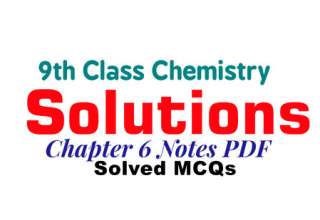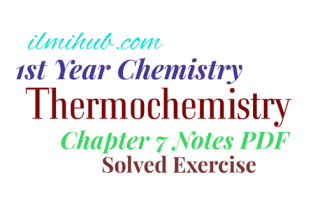In this post, I am sharing FSC 1st Year Chemistry Chapter 9 Short Questions PDF Notes for the students of FSC Part 1. The name of 11th Chemistry Chapter 9 is Solutions. So the students can download Solutions Chapter Short Questions in PDF format from here. This file contains only 09 pages. These Chemistry Notes are for all the boards working under Punjab Board like Gujranwala Board, Lahore Board, Faisalabad Board, Multan Board, Rawalpindi Board, Sargodha Board, DG Kahn Board, and Sahiwal Board. Here are the complete 1st Year Chemistry Notes.
11th Class Chemistry Chapter 9 “Solutions” Short Question PDF Download
What are hydrate? How they are formed?
“those crystalline substances, which contain chemically combined water molecules in definite proportions are called as hydrates”.
e.g.
CuSO4 . 5H2O
Na2CO3 . 10H2O
Formation of hydrates:
generally crystalline compounds are prepared by crystallization of their aqueous solution. In aqueous state, water molecules get attached with the solute particle.
During crystallization, these solute particles arrange them in a regular pattern along with these water molecules, so these water molecules become a part of the crystal lattic to from hydrates.
What is negative derivation from Roult’s law?
“if the solution of two volatile liquids, have a vapour pressure less than the ideal vapour pressure ( as calculated form equation of Raoults law), is said to be showing a negative deviation from Raoult’s law”.
Example;
Mixture of water HCl is an example of negative deviation.
The graph between composition and vapour pressure for such solution is shown as

What is positive derivation from Raoult’s law?
If a solution of two volatile liquids, have a vapour pressure greater than the ideal vapour pressure (as calculated from Rault’s law) such solution are said to be showing positive derivation from the Raoult’s law
Example;
Mixture of ethanol and water is an example of positive derivation.
The graphs between composition and vapour pressure of solution showing positive derivation is shown as;

Give the list of colligative properties.
“The properties of solutions which depend upon the number of solute and solvent particles are called as colligative properties
Following are the colligative properties of dilute solution.
- Lowering of vapour pressure
- Elevation of boiling point
- Depression of freezing point
- Osmotic pressure
Define part per million. Give its mathematical expression:
“ The number of parts (by weight or volume) of a solute dissolved per million parts (by weight or volume) of a solution”.
- It symbol is ppm
- it is used for very low concentration of solution.
Mathematically;
Part per million (ppm) = mass of solute X 106 Mass of solution
Relevant Notes
- 1st Year Chemistry Chapter 1 Short Questions Notes PDF
- 11th Chemistry Chapter 2 Short Questions Notes PDF
- 1st Year Chemistry Chapter 3 Short Questions Notes PDF
- 1st Year Chemistry Chapter 4 Short Questions Notes PDF
- 1st Year Chemistry Chapter 5 Short Questions Notes PDF
- 11th Chemistry Chapter 6 Short Questions Notes PDF
- FSC 1st Year Chapter 7 Short Questions Notes PDF
- 1st Year Chemistry Chapter 8 Short Questions Notes PDF





